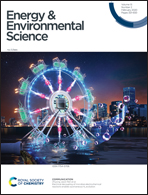Magnetism-induced huge enhancement of the room-temperature thermoelectric and cooling performance of p-type BiSbTe alloys†
Abstract
Bi2Te3-Based alloys are the only thermoelectric material for commercial applications while their low performance is extremely difficult to improve. Herein, superparamagnetic Fe3O4 nanoparticles (Fe3O4-NPs) are incorporated into a commercial p-type Bi0.5Sb1.5Te3 matrix to improve the thermoelectric and cooling performance near room temperature. It is discovered that the Seebeck coefficient of the Fe3O4/Bi0.5Sb1.5Te3 nanocomposites remarkably increased while the thermal conductivity significantly decreased because of the carrier multiple scattering and the enhanced phonon scattering induced by the Fe3O4-NPs, respectively. The maximum ZT reaches 1.5 at 340 K for the nanocomposite with 0.15 wt% of Fe3O4-NPs, being 32% higher than that of the matrix. At near room temperature, the huge cooling temperature difference reaches 5.4 K for a single-leg device made with the nanocomposite, increased by about 3 times as compared with the 1.8 K of the device made with the Bi0.5Sb1.5Te3 matrix. This work reveals that introducing superparamagnetic nanoparticles is a universal approach to simultaneously enhance the thermoelectric and cooling performance of p-type BiSbTe-based alloys.



 Please wait while we load your content...
Please wait while we load your content...